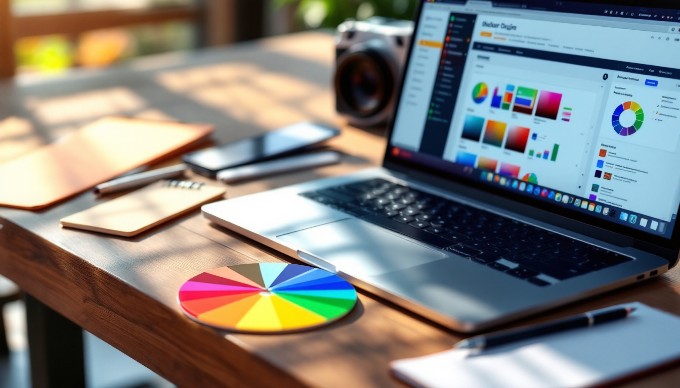Understanding color psychology for websites to enhance design
Introduction to color psychology for websites
Color psychology for websites is a captivating field that explores how different hues and shades can influence user perceptions and behaviors online. Grasping color psychology is essential in web design, as it helps create visually appealing sites that can captivate visitors and guide their actions. By strategically selecting colors, designers can evoke emotions, highlight important elements, and even drive conversions, making it an indispensable tool for enhancing user experience. This article delves into the nuances of color psychology for websites, revealing how the right palette can transform your digital presence and engage audiences more effectively.

The role of color in branding
Understanding color psychology for websites is crucial in creating a compelling brand identity. Colors are more than just visual elements; they are powerful tools that can evoke emotions and influence perceptions. By strategically using colors, brands can craft a unique identity that resonates with their target audience.
Creating a brand identity involves several key elements, with color being one of the most significant. It helps in setting the tone and conveying the brand’s personality. For instance, vibrant colors like red or orange can suggest energy and excitement, while blues and greens often convey trust and tranquility.
Associating colors with emotions is another critical aspect of color psychology. Each color can trigger specific feelings, which can be leveraged to strengthen brand messaging. Here’s how some common colors are perceived:
- Red: Often associated with passion, urgency, and action
- Blue: Conveys trust, reliability, and calmness
- Yellow: Evokes feelings of happiness, optimism, and warmth
- Green: Represents nature, growth, and health
- Black: Signifies luxury, sophistication, and power
Case studies of successful brands highlight how effective color choices can be. For example, Coca-Cola’s iconic red is synonymous with excitement and passion, aligning perfectly with its brand message. Similarly, Facebook’s blue reinforces a sense of trust and community, which is central to its platform.
Incorporating the principles of color psychology for websites can significantly enhance user experience and brand recognition. By choosing the right colors, businesses can create a strong emotional connection with their audience, ultimately driving engagement and loyalty.
Expert graphic design services to elevate your brand. Book a call
Choosing the right color schemes
Understanding how to choose the right color schemes is crucial when applying color psychology for websites. A well-chosen color palette can enhance user experience and convey the right message to your audience. Here are some essential aspects to consider when selecting colors for your website:
Color wheel basics
- The color wheel is a fundamental tool that helps in understanding the relationships between colors. It is typically divided into primary, secondary, and tertiary colors.
- Primary colors are red, blue, and yellow; these cannot be created by mixing other colors.
- Secondary colors are green, orange, and purple, which are made by mixing primary colors.
- Tertiary colors are combinations of primary and secondary colors, adding complexity and depth to your palette.
Complementary vs. analogous colors
- Complementary colors are located opposite each other on the color wheel. They create a high contrast and vibrant look, ideal for grabbing attention. However, they should be used sparingly to avoid overwhelming the viewer.
- Analogous colors are next to each other on the color wheel. They offer a more harmonious and cohesive look, often found in nature. This scheme is perfect for creating a calming and comfortable user experience.
Tools for selecting color palettes
- Online tools like Adobe Color, Coolors, and Canva’s Color Palette Generator can simplify the process of choosing and testing color schemes.
- These tools allow you to explore different combinations and see how they work together, ensuring your website’s colors align with your brand’s message.
- They often provide features to adjust hues, saturation, and brightness, ensuring your chosen palette is both aesthetically pleasing and effective in conveying your intended psychological impact.
By understanding these principles and utilizing available tools, you can create a color scheme that not only aligns with color psychology for websites but also enhances the overall user experience.
Color psychology and user experience
Color psychology plays a pivotal role in shaping the user experience on websites. By thoughtfully selecting colors, designers can influence user emotions, enhance readability and usability, and ensure color accessibility for all users.
Colors have the power to evoke specific emotions and reactions. For instance, warm colors like red and orange can create feelings of excitement or urgency, while cool colors like blue and green often evoke calmness and trust. Understanding these emotional impacts can help in designing websites that align with the brand’s message and desired user interaction.
Enhancing readability and usability is another critical aspect of color psychology for websites. The right color combinations can make text more legible and navigation more intuitive, leading to a smoother user experience. Consider the following strategies for improving readability:
- Use high-contrast color schemes to distinguish text from background
- Choose complementary colors for text and headings to guide the user’s eye
- Avoid using overly bright colors that can strain the eyes
Color accessibility is essential to ensure that all users, including those with visual impairments, can effectively engage with your website. Implementing accessible color practices not only broadens your audience but also enhances overall usability. Key considerations include:
- Selecting color palettes that are distinguishable for individuals with color blindness
- Providing alternative text for color-coded information
- Testing color choices with accessibility tools to ensure compliance with standards
By integrating these elements of color psychology thoughtfully, websites can deliver a more engaging and inclusive user experience, ultimately leading to higher user satisfaction and conversion rates.
Cultural significance of colors
Understanding the cultural significance of colors is crucial when applying color psychology for websites, especially for those targeting a global audience. Colors can evoke different emotions and meanings depending on cultural contexts, which can significantly impact user experience and engagement.
Variations in color meanings across cultures can be profound. For example, the color white is often associated with purity and weddings in Western cultures, while in some Eastern cultures, it symbolizes mourning and funerals. Similarly, red can denote luck and prosperity in China, but it may represent danger or caution in other parts of the world.
When designing websites for a diverse audience, adapting designs to accommodate these cultural differences is essential. Here are some strategies to consider:
- Conduct research to understand the cultural connotations of colors in your target markets.
- Avoid using colors that have negative or sensitive connotations in specific cultures.
- Consider using neutral colors if you aim to appeal to a broad, international audience.
Examples of culturally sensitive color choices include using green for environmental websites, as it universally represents nature and sustainability. Alternatively, incorporating blue in corporate websites can convey trust and professionalism across many cultures.
By acknowledging these cultural nuances, you can create a website design that resonates with users worldwide, enhancing their experience and fostering a deeper connection with your brand. This approach not only respects cultural differences but also leverages color psychology to optimize your website’s effectiveness.
Testing and optimizing colors for your website
Understanding the impact of color psychology for websites is crucial, but testing and optimizing these colors can significantly enhance user experience and conversion rates. To ensure your website’s color scheme effectively engages your audience, consider implementing the following strategies:
-
A/B testing for color effectiveness
A/B testing is a powerful method to determine which color combinations resonate best with your audience. By creating two versions of a webpage with different color schemes, you can compare user interactions and preferences. Monitor metrics such as click-through rates and time spent on page to identify which colors lead to better engagement. This data-driven approach helps ensure your color choices align with your audience’s expectations and psychological responses. -
Using analytics to measure impact
Analytics tools are essential for understanding how your color choices affect user behavior. Track key performance indicators such as bounce rates, conversion rates, and session duration. These metrics provide insights into how effectively your color scheme maintains user interest and encourages desired actions. By analyzing this data, you can make informed decisions about whether to maintain or adjust your current color strategy. -
Iterative design improvements
The process of optimizing your website’s colors is ongoing. Regularly update and refine your color choices based on user feedback and performance data. This iterative approach allows you to continuously improve your site’s visual appeal and functionality. Keep testing new color combinations and stay informed about trends in color psychology to ensure your website remains relevant and engaging.
By integrating these practices, you can effectively leverage color psychology to enhance your website’s performance and user satisfaction.

Conclusion on color psychology for websites
In conclusion, understanding and leveraging color psychology for websites can significantly enhance user engagement and conversion rates. By strategically selecting colors that align with your brand identity and resonate with your target audience, you can create a more inviting and intuitive user experience. Key points discussed include the emotional and psychological impact of different colors, the importance of cultural considerations, and the role of contrast and harmony in design. Effective color use not only captures attention but also guides users through your website seamlessly, highlighting calls to action and enhancing readability.
Ultimately, the power of color psychology for websites lies in its ability to subtly influence user behavior and perceptions. As you design or revamp your website, experiment with different color palettes and monitor user responses to find the combination that best supports your goals. This exploration will not only deepen your understanding of your audience but also optimize your site for improved performance and success. Embrace the potential of color psychology today, and watch your website transform into a more dynamic and engaging platform.
Boost Engagement with Conversion-Driven Design
Enhance usability with optimized designs that convert users into customers.
Learn More